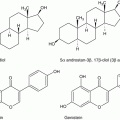Fat cell steroid production
Insulin secretion
Androgen synthesis by the ovaries
Sex hormone binding globulin production by the liver
Gonadal axis is closely linked to the nutritional status. Critical percentage of body fat is necessary for maintaining regular menstrual cycles. Gaining weight can be detected as stressor influencing gonadal axis. On the other hand, adaptive mechanisms exist. In a moment of adaptive mechanism insufficiency, anovulation occurs and menstrual irregularities happen.
Lim et al. [1] showed the results of meta-analysis of overweight, obesity, central obesity in women with polycystic ovary syndrome (PCOS). They included 35 studies, on 15,129 women. Conclusion was made that women with PCOS had increased prevalence for overweight (1.95), obesity (2.77), central obesity (1.73), compared to controls.
The prevalence of obesity is increasing and has an important bearing on the phenotype of PCOS. Some studies suggested that higher body mass index is associated with greater prevalence of menstrual irregularities, hyperandrogenism, and hirsutism, but more studies are required to confirm this.
Increased BMI and visceral adiposity are associated with insulin resistance in the general population, but its effects on menstrual irregularities and hirsutism remain unclear. Lifestyle management results in weight loss and improve surrogate markers of metabolic disease [2].
Polycystic ovary disease results from the interaction between androgen excess with environmental factors, such as abdominal adiposity, obesity, and insulin resistance [3]. It represents the major risk factor for diabetes mellitus. Obesity is an exacerbating factor in the development of type II diabetes mellitus. The risk of type II diabetes mellitus is markedly elevated in women with PCOS (Table 10.2) at middle age and therefore reinforces the need for routine screening of PCOS for diabetes over time [4].
Table 10.2
Indications for screening for diabetes
Hyperandrogenism with anovulation |
Acanthosis nigricans |
BMI > 30 kg/m2 or BMI >25 kg/m2 in Asian population |
In women with family history of diabetes mellitus type |
Besides diabetes, cardiovascular diseases represent the most important diseases as a consequence of obesity (Table 10.3) [5].
Table 10.3
PCOS-related coronary vascular diseases risks
Obesity |
Cigarette smoking |
Hypertension |
Dyslipidemia |
Subclinical vascular diseases |
Coronary vascular diseases in male relatives younger than 55 years of age and female relatives younger than 65 years of age |
At high risk: vascular or renal diseases, type II diabetes |
In obese women with PCOS, hyperinsulinism is detected. It influences gonadal axis (Table 10.4).
Table 10.4
Effects of hyperinsulinism
Increases gonadotropin sensitivity to gonadotropin-releasing hormone (GnRH) |
Activates ovarian insulin receptor to cause activation of the P450c17 enzyme |
Activates insulin-like growth factor 1 (IGF1) receptor |
Decreases sex hormone binding globulin (SHBG), insulin-like growth factor binding protein 1 (IGFBP1) |
Increases testosterone, estradiol (FSH induced), androstendione (LH induced) |
Insulin and LH influence steroidogenesis in theca cells from cholesterol to testosterone. These steps involve P450c17 alfa. Diamanti-Kandarakis E [6] showed insulin signaling defects in PCOS.
Growth hormone has a special role in maintaining body mass. Obesity is characterized by decreased growth hormone secretion, while chronic starvation is characterized by growth hormone resistance. IGF1 may be low in both extremes, and androgen levels may be abnormal. Free testosterone levels across the body weight spectrum are detected [7]. Pooled overnight, IGF1 levels were associated with pooled free testosterone levels across the body composition spectrum.
Visceral fat is the most significant variable correlating with metabolic dysfunction in women with polycystic ovary syndrome [8].
Stay updated, free articles. Join our Telegram channel

Full access? Get Clinical Tree




